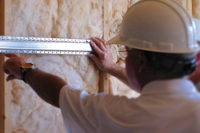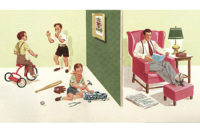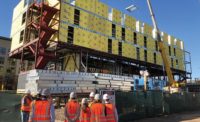Driven by shifts in homebuyer demographics and a growing attraction to urban living, multifamily housing is hotter than ever. The National Association of Home Builders anticipates 384,000 multifamily starts in 2017, which would be 1,000 units above last year’s pace. This trend solidifies the need to ensure multifamily homes offer the same comfort, safety and energy efficiency people expect from single-family dwellings. After all, would you invest in a high-end penthouse apartment if you knew it would feel like living in an attic?
To meet these expectations and adjust to changes in building code, multifamily builders and contractors are shifting their approach toward compartmentalizing each individual unit as if it were a single-family structure. This allows the owner/tenant greater control over the indoor environment and reduces air leakages that can stress mechanical heating and cooling equipment and lead to other issues within the structure.
The problem is that a shortage of approved air sealing materials has left contractors few choices for effective, long-term sealing solutions for individual units, particularly at fire-rated area separation walls. Dated methods like canned foams and caulks are ineffective and lack a long-term performance scenario that will provide the occupants enhanced efficiency and comfort. The good news is that building professionals now have an easier way thanks to customizable air sealing solutions and recent updates to separation wall designs approved by Underwriters Laboratories (UL).
Case for Compartmentalization
Research has shown that good compartmentalization in multifamily and single family attached construction is vital for fire, smoke, odor, contaminant, and sound control. To understand why this is so important from an air movement standpoint, consider how air moves through a typical two-story detached home. The upper floor is often much warmer than lower floors, and an open window in one room can significantly impact air temperatures throughout the rest of the house.
Unsealed party walls create a similar dynamic in multifamily and single family attached structures. The focus of compartmentalization is to isolate the individual metered living units, allowing them to operate independently and limit outside influences from negatively impacting efficiencies and comfort of these living spaces.
When air is allowed to move freely between units, it can also carry unwanted odors (think unpleasant cooking smells) and noise. In units that attached garages are present, emissions and off gassing from cars, paints, gasoline, cleaners and solvents are drawn into units as air from unconditioned areas is exchanged through the joints, cracks and voids within the wall assemblies. Allergens like pet dander and pollen move across these channels, as well, making it a potential health concern.
Up to Date with Codes
Not only is air sealing a comfort issue, building codes are increasingly requiring it. The 2012 International Energy Conservation Code (IECC) has an air exchange requirement of three air changes per hour at 50 Pascals (3 ACH50) for residential construction in climate zones 3-8. This is down from the 7 ACH50 prescribed in 2009 code. Other programs, such as the LEED and ASHRAE Standard 189, have similar or even more stringent requirements.
Sealing area separation walls is a key component in keeping air movement below these performance thresholds. Yet doing so remains a challenge due to the way fire-rated wall assemblies are constructed. A common 2-hour fire-rated assembly (UL 263) incorporates a 2-inch vertical H-stud and gypsum panel in the middle of the assembly. This results in an airflow network that is connected over multiple units and floors, while also having potential connections to exterior conditions where the system terminates at the exterior building envelope.
Although the core of the separation wall is relatively monolithic, the wall assembly to either side of the core has many mechanical, electrical, and structural penetrations, which are connected to the air space. Similarly, bathtubs and stairwells on common walls have high risks of air leakage. Assemblies need to be developed that improve air tightness and simultaneously address fire, acoustic, and moisture issues. At the same time, air sealing details must be durable and accommodate movement of materials and structure.
Sealant Solution
Adopting a single-family approach to sealing each individual unit can be a cost-effective strategy for achieving higher energy efficiency while staying within air exchange limits mandated by today’s building codes. It can also ensure more reliable suite ventilation in buildings with shared ventilation systems.
Yet many materials commonly used to seal air gaps are not approved for use in fire-rated assemblies. UL 263 Designs have not allowed non-UL listed sealants, such as caulks, single- and two-part foams, to be used in these applications. Fire-blocking sealants approved for use in framing penetrations are not listed for use in these types of designs, either.
So what can builders and contractors do? Fortunately, UL recently approved the first air sealing material for use in fire-rated party walls, clearing a path for greater adoption of multifamily and single family attached compartmentalization going forward.
The product, EcoSeal Plus from Knauf Insulation, is a water-based, elastomeric spray-on sealant that fills gaps, seams and joists and then quickly dries to a flexible but tough barrier and gasket. It has specifically been approved and included in UL design U336, which allows for a bead of sealant around the partition perimeter, and at the interface between wood or steel framing and gypsum board panels to create an air barrier.
The elastomeric sealant is a very simple install. It is applied in a single pass application with an airless paint sprayer and is ready to apply right out of the bucket, significantly reducing impacts on building schedules. It doesn’t contain any hazardous chemicals and won’t off gas VOCs, meaning crews don’t have to wear special safety equipment and other trades can continue work during installation. Any mess is easily cleaned up with water and the material can be applied in a wide range of temperatures.
I expect we will begin to see greater adoption of this approach in the wake of UL’s approval of products such as these in fire-rated party walls. Given recent growth in the multifamily and single family attached housing markets, builders and contractors are looking for any advantage they can to grow their business and offer a superior product. Armed with a simpler, more effective means of compartmentalizing units, multifamily builders and contractors can provide more comfortable and efficient homes for their customers and make efficient and comfortable living more attractive than ever to potential buyers.








Report Abusive Comment